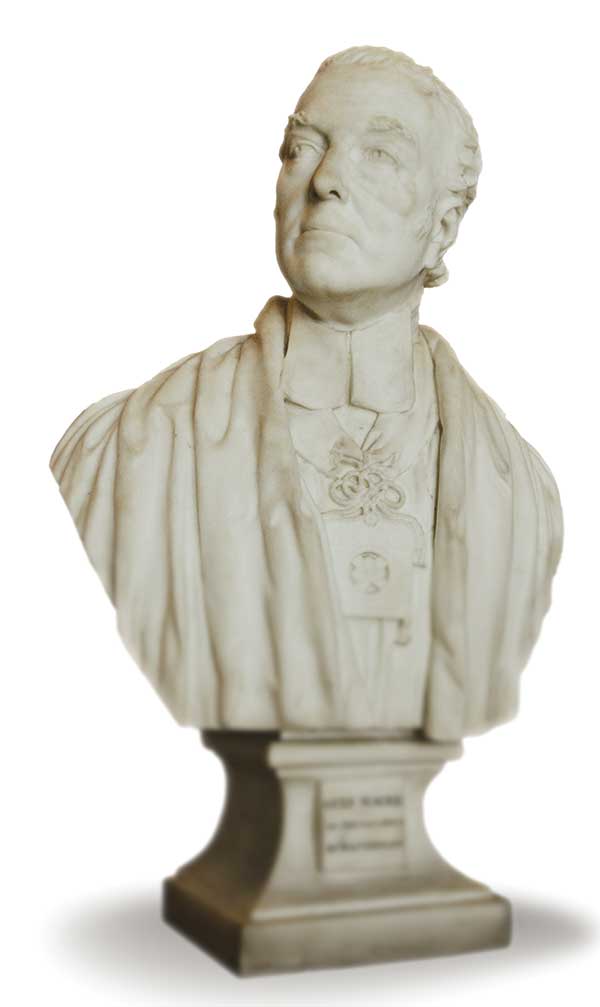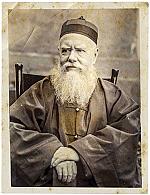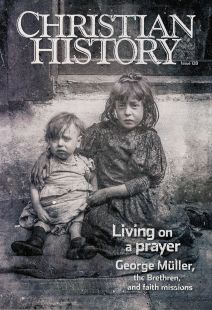Müller and friends

[William Magee]
IN 1828 two well-off young men, a dentist and a lawyer, walked along Lower Pembroke Street in the heart of Dublin, speaking earnestly about a group of Christians from various churches who had begun meeting privately. The dentist, Anthony Norris Groves (1795–1853), suggested to the lawyer, John Gifford Bellett (1795–1864), that God wanted the little company to come together in all simplicity as disciples, not waiting on any pulpit or minister, but trusting that the Lord would edify us together, by ministering as He pleased and saw good from the midst of ourselves.
Many years later Bellett could still point out the spot; for him, it was “the birth place of my mind.”
broad and pure
Groves expressed the motivation of the pioneers of the so-called Plymouth Brethren. In search of simplicity and unity, they sought a fellowship broad enough to embrace all believers in Christ and yet pure enough to exclude churchgoers lacking a living faith. Their vision was to provide a fellowship in which all true believers could worship together around the Lord’s table and could study the Scriptures without being divided by denominational allegiance.
Small groups of seceders from established groups with this aim popped up in Dublin and the north of Ireland. All believed that the Bible offered the best pattern for ordering church life, taking the unofficial name “Brethren.”
In the late 1820s, three important groups emerged in Dublin. The first centered on Edward Cronin (1801–1882), a Catholic who had become Independent (Congregational) after an evangelical conversion. When he moved to Dublin in 1826, he was told he couldn’t take Communion regularly unless he joined a local Independent church. He refused, believing that what was necessary was membership in Christ’s body rather than in a local congregation. His “growing feeling of opposition to one man ministry” led him to stop attending church altogether: “To avoid the appearance of evil, I spent many a Lord’s-day morning under a tree or under a haystack during the time of service.” With others he began to “break bread” in the back parlor of his house.
Meanwhile a group of Anglicans and Nonconformists (Protestants who did not “conform” to the Church of England) sought to share Communion together. With the financial support of John Vesey Parnell, later Lord Congleton (1805–1883), they began meeting.
A third group centered on Anglican Evangelicals (modern historians tend to capitalize the word when it refers to this specific faction). Among them were Bellett and Groves. Groves was preparing to go to Baghdad as a missionary and had offered himself for service with the Anglican Church Missionary Society (CMS). For this assignment Anglican ordination was required, and he stayed at Bellett’s house when visiting Dublin for examinations at Trinity College.
But in 1827 a burglar stole the money he had set aside for his next trip, and Groves took this as divine guidance to withdraw from his course. He was still keen to go to Baghdad as a layman, but the CMS told him that without ordination he would be unable to celebrate the Lord’s Supper. Groves concluded that “ordination of any kind to preach the gospel is no requirement of Scripture.” He withdrew from the CMS but continued with his missionary plan.
How these three groups came together is not clear, but by 1830 they were meeting as one in a rented auction room in Dublin. Their main burden was what they saw as the unscriptural nature of “special membership” in a denomination; this belief resulted in their being shunned as “Evangelical malcontents.”
servants of the state
At some point John Nelson Darby (1800–1882), a clergyman in Powerscourt, south of Dublin, made contact with the group. His parish included Protestant gentry, many influenced by Anglican Evangelicals, but also poor Catholic agricultural laborers. They became Darby’s responsibility, and he wore himself out in ministry to them.
In October 1826 the Anglican archbishop of Dublin, William Magee, issued a charge to his clergy that portrayed them as servants of the state as well as the church. Catholics protested; Anglican clergy sought state protection; and early in 1827 Magee imposed oaths of supremacy and allegiance on prospective converts, which upset Darby greatly.
These oaths acknowledged the British monarch as head of state and supreme governor of the Church of England and Ireland, and abjured allegiance to other rulers, including the pope. Darby saw this as the church seeking the support of worldly government. He published a pamphlet stating his objections and asserting that the church as a heavenly entity should be independent of the state. Significantly he did not secede: the Church of Ireland might be in captivity to the state, but Darby still saw it as the church.
While convalescing from a riding accident in October 1827, however, he came to a new assurance of faith. This not only gave him a sense of rest regarding his personal salvation, but also left him convinced the Bible is a Christian’s sole authority, which would remain even if the church should cease to exist. Gradually he moved out of the established church and took his place among the Dublin seceders.
But the whole movement might have died away without Theodosia, the wealthy and pious countess of Powerscourt (1800–1836), whose home lay within Darby’s parish. She had a strong interest in scriptural prophecy and opened her home to conferences on the subject.
These brought together many emerging Brethren leaders, along with evangelicals who preferred to remain in existing churches. In time the latter withdrew from the conferences, and those who remained developed a common mind. Their interpretation of Scripture developed into dispensationalism, marked by a negative estimate of contemporary society and of the future of organized Christendom. Here at last was a strong common thread and a powerful driver for secession from the established church.
By 1829 Groves had followed his missional calling to Baghdad and taken others with him. Meanwhile new people joined the Brethren in 1830, including Cronin, Parnell, and Francis Newman (1805–1897), younger brother of Anglican priest John Henry Newman. (John Henry would famously convert to Catholicism in 1845 and become a cardinal in 1879.)
Ireland proved largely barren soil for Brethren outreach until a revival almost 30 years later that lasted from 1858 to 1862. Many early leaders came from the Protestant gentry, which alienated Catholics; Darby even received a death threat for “Seducing the people . . . by your Bible business.” Many Evangelicals distanced themselves from the new movement because of its radicalism, potential for divisiveness, and novel views of biblical prophecy.
Evangelicalism shaped the new movement, but followers felt it did not go far enough and sought a more radical obedience to Scripture, free of the weight of denominational traditions, and wanted to recover a living sense of the Holy Spirit at work.
Paradoxically they were both seceders (open to accusations of sectarianism) and ecumenists (seeking a fellowship broad enough to embrace all believers). Sometimes one was emphasized, sometimes the other. Early Brethren were like an unstable chemical compound; as the movement spread to England, that instability would cause a chain reaction.
moving to Oxford
During the late 1820s, the university city of Oxford had witnessed the rise of a strident Evangelicalism, critical of the established church. Among those affected were Benjamin Wills Newton (1807–1899), newly converted from a Quaker background; G. V. Wigram (1805–1879); and Francis Newman. Newman met Darby while in Dublin during 1827–1828 as a private tutor and returned to Oxford with a newfound zeal for studying prophecy with others. Newton later recalled, “Newman introduced to me Prophetic Truth and it turned the whole current of my life.”
But when Newman himself studied the New Testament afresh as the Brethren recommended, he came to reject the divinity of Christ and the reality of the supernatural. In turn the Brethren rejected him.
From Oxford the movement traveled further south and west to the county of Devon, which proved fertile soil for the Brethren message. This was Groves’s home. His personal example influenced many early Brethren, among them Müller, whose Bible study had led him to views similar to Groves and Henry Craik.
Meanwhile Newton had settled in the coastal town of Plymouth—about 30 miles from Müller and Craik. He invited his old Oxford friend Wigram to the city, and in 1831 Wigram began to hold meetings for prophetic study. As in Dublin, meetings were initially timed to avoid clashing with church services, and local clergy attended. The group began to break bread together, initially on Monday evenings, but later on Sunday mornings.
One colorful early leader, Percy Hall (1801–1884), like most early Brethren, adopted pacifist views; he published a pamphlet explaining why he had resigned as a naval officer. He too sold most of his possessions and began to live simply. Hall may have been the first of the Brethren to preach the idea that Christ would rapture believers before the tribulation of the end times, which became a hallmark of Brethren teaching.
Close fellowship and radical economic sharing marked the growing gathering: “The homes of the wealthy were plainly furnished, presenting an air of unworldliness and making them more homely for their poorer brethren and sisters.” Such radicalism attracted many; some moved to Plymouth to share in it. One writer in 1834 summed up the group’s standpoint as “Separation from the world, union of the saints, and the liberty of, and dependence on the Holy Ghost, according to the [W]ord.”
Leaders of the movement in various parts of England dedicated their full-time work to Christian ministry and planted networks of local assemblies (as they were called), which they served as unpaid pastors. In north Devon a Baptist church at Barnstaple metamorphosed into a Brethren assembly as a result of the ministry of its pastor, Robert C. Chapman (1803–1902). Concern for the poor motivated his commitment to a simple lifestyle, and he chose to live in a humble part of town.
a solemn pause
Sometimes entire existing congregations and groups of congregations aligned with the Brethren. The Quakers, who had split from the established churches around 1650 (see CH #117), were now reeling from turmoil following a controversy over evangelical ideas.
Several hundred Quakers seceded, and some founded Brethren gatherings. Quakers helped to strengthen Brethren commitment to open, unstructured worship—although few assemblies followed Quakers in allowing the public ministry of women. In addition Quakers and Brethren began to intermarry, which further spread Brethren ideas into Quaker families.
Another group in northwest England, the “Barkerites” or “Christian Brethren,” began as a Methodist schism, but some congregations developed into Brethren assemblies. In 1843 their short-lived magazine, The Christian Brethren’s Journal and Investigator, described the most typical early Brethren meeting, the meeting for Bible reading:
Each has his Bible, and . . . they read round, verse by verse. . . . When the portion fixed upon has been read through, a solemn pause ensues, during which all silently lift their hearts to God for the guidance of his Spirit; and then if anyone has a question to ask respecting the portion of Scripture that has been read, he asks it, and it is considered; and if any one present has light on the subject, it is answered.
Other assemblies had their roots in the ministry of Scottish preacher John Bowes (1805–1874), previously a Methodist. He traveled widely, engaged in public debates, and founded gatherings in Scotland and England, a few of which developed into Brethren assemblies. He illustrates the fluidity of Brethrenism as people and congregations moved in and out of Brethren circles. Magazines and conferences for prophetic study provided some cohesion.
Müller set his roots down in Bristol where he and Craik ministered in Bethesda Chapel. Darby felt they needed “a little more principle of largeness of communion” at Bethesda, and Chapman influenced them to stop requiring that applicants for membership should be baptized as believers.
By 1840 Groves estimated the Brethren had 200 assemblies in Britain and Ireland. Brethren also attempted to start work elsewhere. Switzerland had experienced an evangelical awakening, the Réveil, from 1815 on, and Darby visited the country. Initially he worked within existing churches, but he formed separate gatherings once Swiss Calvinists condemned his teaching in 1840.
Persia proved hostile to Groves and his colleagues, and in 1835 they moved to India. There, after controversy resulting from Groves’s attempt to work with the CMS, a Brethren work developed around the Godavari Delta. In what is now British Guyana, an ex-clergyman, Leonard Strong, adopted Brethren beliefs in 1837 and formed a large assembly, possibly motivated by a desire to minister to slaves working the plantations.
Müller provided some support for work overseas through his Scripture Knowledge Institution, but this was the only agency to do so. Many Brethren opposed forming para-church agencies. Only later would they acquire a reputation for being mission-minded.
what kind of unity?
The Brethren rejected ordination, but many of the early leaders were former clergy. The movement was neither democratic nor led by the working class. Its strong leadership proved to be its undoing. Between 1845 and 1848, a catastrophic division occurred centering on a clash between strong-minded leaders. In 1832 Darby had told a group: “You are nothing, nobody, but Christians”; the moment they ceased to offer fellowship to any consistent Christian, he added, they would either become divided themselves or promote sectarianism. His warning proved prophetic.
Groves also expressed concern over sectarianism. He saw a tendency to make light rather than life the basis of fellowship—to fellowship with those who agreed doctrinally rather than those who shared the experience of life in Christ. To make things worse, Darby and Newton were diverging in their understanding of prophecy. Newton did not accept Darby’s understanding of the rapture. Nor did Müller. Darby also felt marginalized and unwelcome at Plymouth.
But the climax came in 1847 when Darby became aware that Newton taught that some of Christ’s sufferings were due not simply to the imputation of human sin, but to his voluntary identification with fallen humanity that required him to clear himself by obeying the Father’s will. Müller said that Newton’s Christ needed a Savior.
When Bethesda welcomed into membership two ex-members of Newton’s assembly, Darby refused to preach there. He demanded that Bethesda investigate and condemn Newton’s errors. Müller and Craik initially refused, then condemned Newton’s errors but still did not investigate, and they continued to receive into communion those who had sat under Newton’s ministry if they were personally sound in faith.
Darby argued that it was impossible for Bethesda to exclude Newton’s errors without excluding his followers. For him a believer who even associated with those who taught error became infected: “For my own part I should neither go to Bethesda in its present state, nor while in that state go where persons from it were knowingly admitted.” He believed unity should be universal—but also that doctrinal agreement should be visible.
Newton republished his tracts that autumn, but because he did not retract his errors, Müller brought the matter to the church. Bethesda now determined not to receive anyone defending Newton’s views. Darby approved but urged Bethesda to withdraw earlier statements. Bethesda refused, and the movement split. When in 1849 Darby called on Müller to seek renewed fellowship, the latter refused in protest.
What became known as the Open Brethren asserted that each assembly had the right to conduct its own affairs in the light of responsibility to Christ and to welcome true believers to the Lord’s table. Exclusive Brethren followed Darby in asserting that “separation from evil” was the basis for unity. An individual disfellowshiped by one meeting was out of communion with all; any meeting accepting such a person was regarded as infected with spiritual evil.
Assemblies divided; friends were alienated; suspicion replaced hospitality. The movement to bring Christians out of dividing denominations into one fellowship was irreversibly damaged. Division between Open and Exclusive Brethren remains today. C H
By Tim Grass
[Christian History originally published this article in Christian History Issue #128 in 2018]
Tim Grass is a senior research fellow at Spurgeon’s College and the author or editor of books on the Brethren including Gathering to His Name and a biography of F. F. Bruce.Next articles
Caught up to meet Jesus in the clouds
John Nelson Darby’s view of the last things has dramatically outlived him
Roger RobinsSupport us
Christian History Institute (CHI) is a non-profit Pennsylvania corporation founded in 1982. Your donations support the continuation of this ministry
Donate







